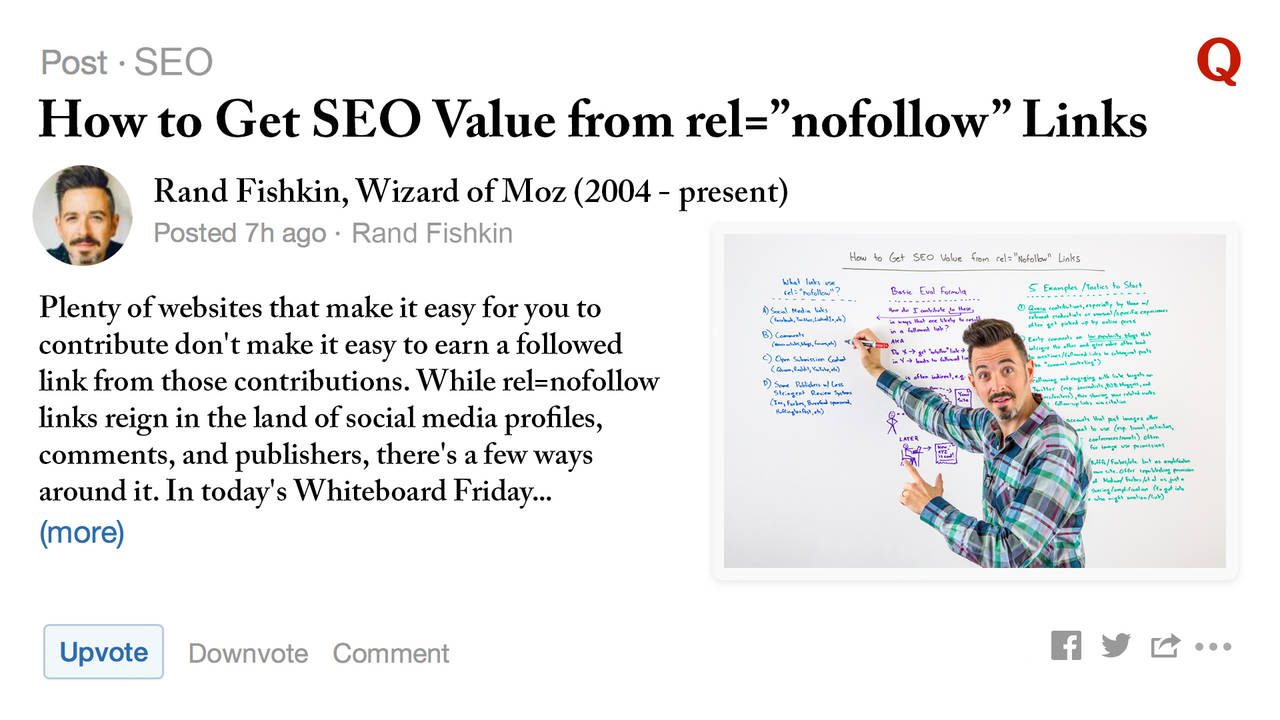While rel=nofollow links reign in the land of social media profiles, comments, and publishers, there's a few ways around it. Recently you might have seen in the SEO news world that Inc. and Forbes and a few other sites like them, last year it was Huffington Post, started applying nofollow tags to all the links that belong to articles from contributors. Social media, so Facebook, Twitter, and LinkedIn, which is one of the reasons why you can't just boost your linked profile by going to these places and leaving a bunch of links around. Some publishers now with these less stringent publishing review systems, so places like Inc., Forbes, BuzzFeed in some cases with their sponsored posts, Huffington Post, LinkedIn's Pulse platform, and a bunch of others all use this rel=nofollow. So we're essentially saying I'm going to do X. I know that's going to bring a nofollowed link, but that nofollowed link will result in this other thing happening that will then lead to a followed link. You post something with your site on one of these places. Later, as that editor is writing, they will link over to your site, and this will be a followed link. You've indirectly gained SEO value essentially through amplification of what you were sharing through your link. They want you to use all of these places to show stuff, and then they're hoping that if people find it truly valuable, they'll pick it up, they'll link to it, and then Google can reward that.

Plenty of websites that make it easy for you to contribute don’t make it easy to earn a followed link from those contributions. While rel=nofollow links reign in the land of social media profiles, comments, and publishers, there’s a few ways around it. In today’s Whiteboard Friday, Rand shares five tactics to help you earn equity-passing followed links using traditionally nofollow-only platforms.

.

Click on the whiteboard image above to open a high-resolution version in a new tab!
Video Transcription
Howdy, Moz fans, and welcome to another edition of Whiteboard Friday. This week we’re going to chat about how you can get SEO value from nofollowed links. So in the SEO world, there are followed links. These are the normal ones that you find on almost every website. But then you can have nofollowed links, which you’ll see in the HTML code of a website. You will see the normal thing is a href=somewebsite in here. If you see this rel=nofollow, that means that the search engines — Google, Bing, Yahoo, etc. — will not count this link as passing link equity, at least certainly not in the same way that a followed link would.
So when you see these, you can see them by looking in the source code yourself. You could turn on the MozBar and use the “Show nofollow links” on the Page button and see these.
What sort of links use rel=nofollow?
But the basic story is that you’re not getting the same SEO value from them. But there are ways to get it. Recently you might have seen in the SEO news world that Inc. and Forbes and a few other sites like them, last year it was Huffington Post, started applying nofollow tags to all the links that belong to articles from contributors. So if I go and write an article for Inc. today, the links that I point out from my bio and my snippet on there, they’re not going to pass any value, because they have this nofollow applied.
A) Social media links (Facebook, Twitter, LinkedIn, etc.)
There are a bunch of types of links use this. Social media, so Facebook, Twitter, and LinkedIn, which is one of the reasons why you can’t just boost your linked profile by going to these places and leaving a bunch of links around.
B) Comments (news articles, blogs, forums, etc.)
Comments, so from news articles or blogs or forums where there’s discussion, Q&A sites, those comments, all the links in them that you leave again nofollowed.
C) Open submission content (Quora, Reddit, YouTube, etc.)
Open submission content, so places like Quora where you could write a post, or Reddit, where you could write a post, or YouTube where you could upload a video and have a post and have a link, most of those, in fact almost all of them now have nofollows as do the profile links that are associated. Your Instagram account, for example, that would be a social media one. But it’s not just the pictures you post on Instagram. Your profile link is one of the only places in the Instagram platform where you actually get a real URL that you can send people to, but that is nofollowed on the web.
D) Some publishers with less stringent review systems (Forbes, Buzzfeed, LinkedIn Pulse, etc.)
Some publishers now with these less stringent publishing review systems, so places like Inc., Forbes, BuzzFeed in some cases with their sponsored posts, Huffington Post, LinkedIn’s Pulse platform, and a bunch of others all use this rel=nofollow.
Basic evaluation formula for earning followed links from the above sources

The basic formula that we need to go to here is: How do you contribute to all of these places in ways that will ultimately result in…

COMMENTS